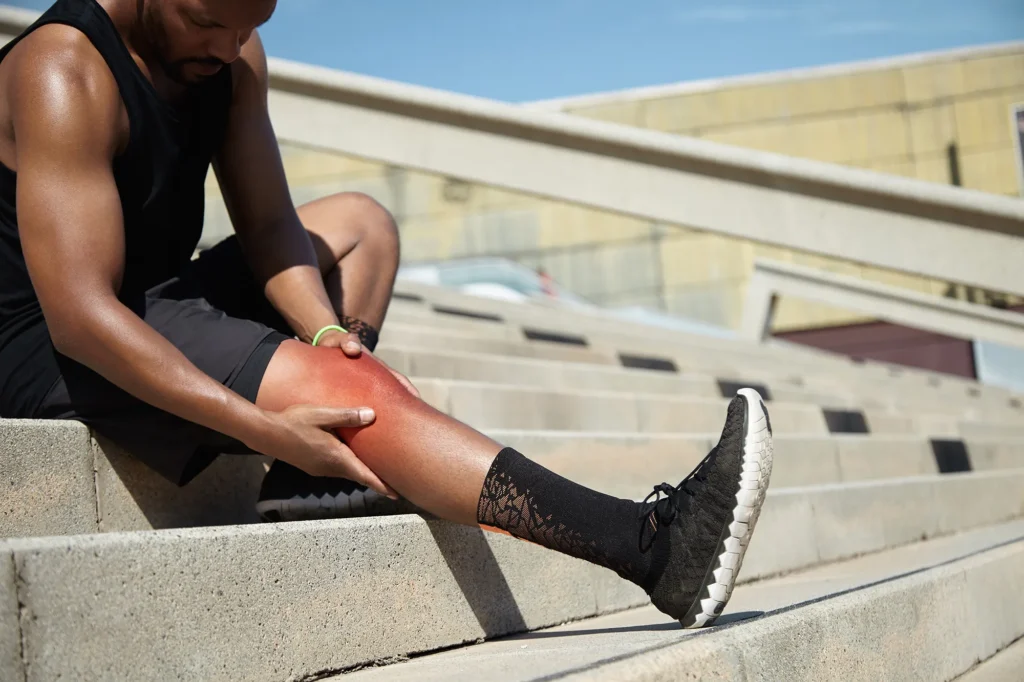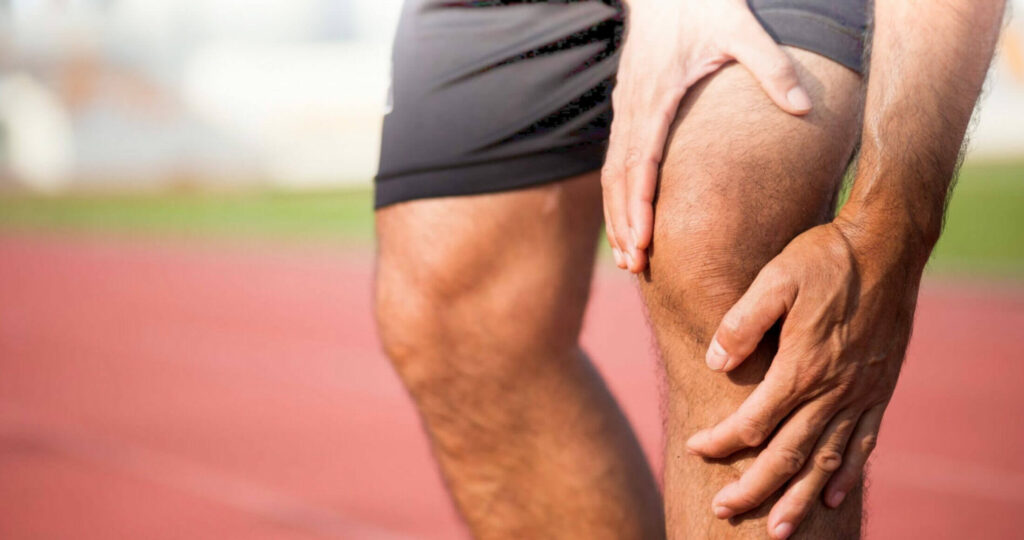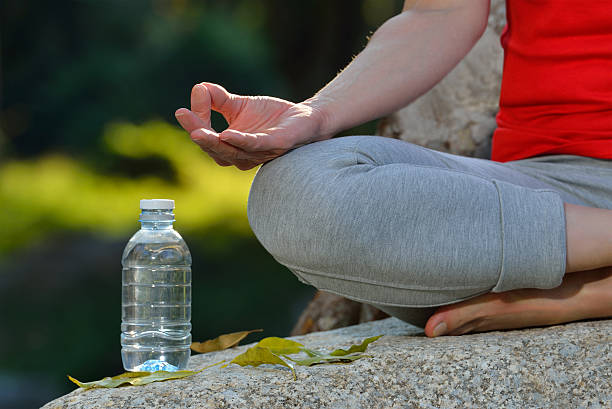In the world of fitness and sports, running is an age-old activity that provides countless benefits, from improved cardiovascular health to stress relief. Yet, for many avid runners, the rhythmic pounding of feet against the pavement can come with a potentially painful and frustrating consequence: runner’s knee. This common condition, known as patellofemoral pain syndrome or simply runner’s knee, affects runners of all levels, from beginners to seasoned marathoners. It’s a condition that, if left untreated or unmanaged, can quickly put a halt to one’s running journey.

Runner’s knee is not just an inconvenience; it’s a complex and multifaceted issue that can impact an individual’s overall quality of life. In this comprehensive article, we delve deep into the world of knee inflammation from running, offering a wealth of knowledge and guidance to help runners understand, prevent, and manage this condition effectively.
Check out our Knee Pads for Comfort and Relief
This guide isn’t just for runners already grappling with the discomfort of runner’s knee, but also for those looking to prevent it. We explore the root causes of runner’s knee, the signs and symptoms to watch for, and the various factors that can contribute to its development. Whether you’re a seasoned athlete or just starting your running journey, this article will equip you with the tools and insights you need to make informed decisions about your training and knee health.
Our goal is to provide a comprehensive resource that covers everything you need to know about runner’s knee. We’ll delve into the biomechanics of running, the importance of proper form, the role of footwear, and the significance of cross-training to maintain knee health. We’ll also explore the most effective strategies for managing runner’s knee when it does occur, including physiotherapy, exercises, and lifestyle adjustments.
So, if you’ve ever wondered why your knees ache after a long run, or if you’re currently struggling with the pain and frustration of runner’s knee, you’ve come to the right place. This article is your ultimate guide to understanding, preventing, and managing knee inflammation from running, empowering you to pursue your passion for running with confidence and longevity. Let’s lace up our running shoes and embark on this informative journey toward healthier, happier knees.
The Anatomy of Runner’s Knee
Before we dive deeper into the nuances of preventing and managing runner’s knee, it’s essential to understand the anatomy of this condition. Runner’s knee typically involves inflammation of the patellofemoral joint, where the kneecap (patella) articulates with the thigh bone (femur). This delicate interplay between bones, cartilage, and tendons allows the knee to bend and straighten with each step.
In runner’s knee, this dynamic balance can be disrupted, leading to friction, irritation, and pain. The exact cause of this condition can vary from person to person and may include factors such as overuse, muscle imbalances, poor running form, or biomechanical issues.
Recognizing the Signs and Symptoms
Runner’s knee often makes its presence known through a range of symptoms. These can include:
- Pain around or behind the kneecap: The pain may be dull and achy, or it can manifest as a sharp, stabbing discomfort during and after running.
- Swelling: Inflammation can cause the knee to become swollen and tender to the touch.
- Cracking or popping noises: Some individuals with runner’s knee report unusual sounds coming from the knee joint during movement.
- Stiffness: You may experience difficulty bending or straightening your knee fully.
- Weakness: The affected knee may feel weak, making it challenging to complete your usual running routines.
- Pain during prolonged sitting: Many runners with this condition notice discomfort after sitting for extended periods with the knee bent, such as during a long car ride or at a desk.
- Instability: In severe cases, the knee may feel unstable or as though it might give way.
By recognizing these signs and symptoms early, you can take proactive steps to address the issue and prevent it from becoming a more chronic and debilitating problem.
Preventing Runner’s Knee
The best way to deal with runner’s knee is to prevent it from occurring in the first place. Here are some proactive steps to reduce your risk:
- Proper Running Form: Pay close attention to your running technique. Ensure that your stride is not too long, your footfall is well-balanced, and your knees do not collapse inward. Maintaining proper form reduces unnecessary stress on the patellofemoral joint.
- Strengthen the Quadriceps and Hips: Strengthening the muscles surrounding the knee, especially the quadriceps and hip abductors, can provide additional support to the joint. Incorporate strength-training exercises into your routine to improve muscular balance.
- Gradual Progression: Avoid sudden increases in mileage or intensity. Gradually progress your training to allow your body time to adapt to the demands of running.
- Footwear: Invest in proper running shoes that provide adequate cushioning and support for your unique foot structure and gait.
- Cross-Training: Incorporate cross-training activities like swimming, cycling, or yoga into your fitness regimen to reduce the repetitive impact on your knees.
- Proper Warm-up and Cool-down: Prior to running, warm up your muscles with dynamic stretches, and after your run, cool down with static stretches to maintain flexibility.
Managing Runner’s Knee
If you’re already experiencing the discomfort of runner’s knee, don’t despair. There are several strategies and treatments that can help manage the condition and facilitate your recovery:
- Rest and Ice: Give your knee a break from running to allow inflammation to subside. Apply ice to the affected area to reduce pain and swelling.
- Physical Therapy: A physical therapist can help you develop a tailored exercise program to strengthen the muscles around your knee and correct any muscle imbalances or movement issues.
- Bracing: In some cases, wearing a knee brace or patellar strap can provide support and alleviate pain during physical activity.
- Anti-inflammatory Medications: Non-prescription anti-inflammatory medications can help reduce pain and swelling, but consult with a healthcare professional before using them.
- Injections: In severe cases, your healthcare provider may recommend injections of corticosteroids or hyaluronic acid to reduce inflammation and provide pain relief.
- Surgery: In rare cases where conservative treatments fail, surgery may be considered, but it’s typically a last resort.
This article will delve deeper into each of these strategies to help you understand the best approach for your unique situation. We will also provide guidance on lifestyle adjustments and long-term strategies to ensure that runner’s knee becomes a manageable and temporary setback, rather than a roadblock to your running ambitions. By the end of this comprehensive guide, you’ll be well-equipped to take control of your knee health, allowing you to continue your running journey with confidence and comfort.
Lifestyle Adjustments for Long-Term Knee Health
Once you’ve successfully managed your runner’s knee and are back on the road or trail, it’s crucial to make some lifestyle adjustments to maintain the health of your knees and prevent the condition from returning. Here are some tips to consider:
- Listen to Your Body: Pay attention to any signs of discomfort or pain during your runs. If you notice the onset of knee pain, it’s important to address it early by adjusting your running routine or taking a break. Ignoring pain can exacerbate the issue.
- Proper Footwear: Ensure that you replace your running shoes regularly. Running shoes lose their cushioning and support over time, which can lead to increased stress on your knees.
- Surface Selection: Whenever possible, choose softer surfaces like trails or grass for running, as they absorb some of the impact, reducing strain on your knees.
- Regular Stretching and Strengthening: Continue with a consistent routine of stretching and strengthening exercises, even after your symptoms have improved. This will help maintain the balance of your leg muscles and reduce the risk of future flare-ups.
- Maintain a Healthy Weight: Excess body weight can put extra strain on your knees. Maintaining a healthy weight through a balanced diet and regular exercise can help prevent knee issues.
- Stay Hydrated: Proper hydration is essential for maintaining joint health. Make sure you drink enough water throughout the day, especially if you’re an active runner.
- Rest Days: Incorporate rest days into your training schedule to allow your body to recover and reduce the risk of overuse injuries like runner’s knee.
Seeking Professional Guidance
If runner’s knee persists or reoccurs despite your best efforts, it’s essential to seek guidance from a healthcare professional. They can provide a precise diagnosis and recommend a tailored treatment plan, which may include physical therapy, bracing, or other interventions.
Surgery is rarely necessary for runner’s knee, but in some cases, it might be the best course of action. Your healthcare provider will discuss the potential benefits and risks with you.
Conclusion
Runner’s knee may be a common ailment among runners, but it doesn’t have to be a permanent obstacle in your fitness journey. By understanding the condition, recognizing its signs and symptoms, and taking proactive measures to prevent and manage it, you can continue to enjoy the exhilaration of running while keeping your knees in optimal health.
This comprehensive guide has equipped you with valuable insights, tips, and strategies to tackle runner’s knee head-on. Remember that each individual’s experience with this condition is unique, so it’s crucial to tailor your approach to your specific needs and circumstances.
With the right knowledge and a commitment to a holistic approach to knee health, you can minimize the impact of runner’s knee, or even prevent it altogether. So, lace up your running shoes, apply these principles, and embark on a journey of pain-free and fulfilling running experiences. Your knees will thank you, and you’ll continue to thrive on the open road or scenic trails, enjoying the freedom and exhilaration that running provides.





